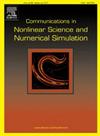Node center identification in complex networks based on Jensen–Shannon divergence
IF 3.4
2区 数学
Q1 MATHEMATICS, APPLIED
Communications in Nonlinear Science and Numerical Simulation
Pub Date : 2025-06-03
DOI:10.1016/j.cnsns.2025.108977
引用次数: 0
Abstract
The evaluation of node centrality remains a critical challenge in the field of complex network research. This paper proposes a novel method, the method, which integrates local and global information to measure node centrality. The method employs Shannon entropy to quantify local centrality and Jensen–Shannon () divergence to compute inter-community distances, thereby assessing topological differences between communities and measuring global centrality. Experiments conducted on both real and random networks evaluated the impact of central nodes identified by the method on network efficiency. Simulation results demonstrate that in networks with distinct community structures, the method provides more accurate node centrality measurements compared to the , , , , and methods. Additionally, the repetition frequency of central ranking nodes indicates that the method effectively distinguishes the centrality of different nodes. Finally, the paper discusses the impact of different combination methods on measurement performance, revealing that incorporating additional community information further enhances the method’s effectiveness.
基于Jensen-Shannon散度的复杂网络节点中心识别
节点中心性的评估一直是复杂网络研究领域的一个关键挑战。本文提出了一种新的节点中心性度量方法——JSD方法,该方法综合了局部和全局信息来度量节点中心性。该方法利用Shannon熵量化局部中心性,利用Jensen-Shannon (JS)散度计算群落间距离,从而评估群落间的拓扑差异,测量全局中心性。在真实网络和随机网络上进行的实验评估了JSD方法识别的中心节点对网络效率的影响。仿真结果表明,在具有不同社区结构的网络中,JSD方法比BC、CCI、CBC、COMM和CI方法提供了更精确的节点中心性测量。此外,中心排序节点的重复频率表明JSD方法可以有效区分不同节点的中心性。最后,本文讨论了不同组合方法对测量性能的影响,揭示了加入额外的社区信息进一步提高了方法的有效性。
本文章由计算机程序翻译,如有差异,请以英文原文为准。
求助全文
约1分钟内获得全文
求助全文
来源期刊

Communications in Nonlinear Science and Numerical Simulation
MATHEMATICS, APPLIED-MATHEMATICS, INTERDISCIPLINARY APPLICATIONS
CiteScore
6.80
自引率
7.70%
发文量
378
审稿时长
78 days
期刊介绍:
The journal publishes original research findings on experimental observation, mathematical modeling, theoretical analysis and numerical simulation, for more accurate description, better prediction or novel application, of nonlinear phenomena in science and engineering. It offers a venue for researchers to make rapid exchange of ideas and techniques in nonlinear science and complexity.
The submission of manuscripts with cross-disciplinary approaches in nonlinear science and complexity is particularly encouraged.
Topics of interest:
Nonlinear differential or delay equations, Lie group analysis and asymptotic methods, Discontinuous systems, Fractals, Fractional calculus and dynamics, Nonlinear effects in quantum mechanics, Nonlinear stochastic processes, Experimental nonlinear science, Time-series and signal analysis, Computational methods and simulations in nonlinear science and engineering, Control of dynamical systems, Synchronization, Lyapunov analysis, High-dimensional chaos and turbulence, Chaos in Hamiltonian systems, Integrable systems and solitons, Collective behavior in many-body systems, Biological physics and networks, Nonlinear mechanical systems, Complex systems and complexity.
No length limitation for contributions is set, but only concisely written manuscripts are published. Brief papers are published on the basis of Rapid Communications. Discussions of previously published papers are welcome.
 求助内容:
求助内容: 应助结果提醒方式:
应助结果提醒方式:


